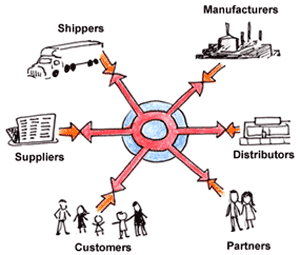How it works: Web services
Putting systems and processes together so that they all work, and then getting them to communicate with suppliers and customers, is a daunting task.  |

| This undertaking has been made simpler by the advent of Web services -- clever software that allows different computers systems to communicate seamlessly through the Web. |
It's no secret that there are many processes that keep a business running. Customer data is housed in databases. Accounting applications handle billing and purchasing. Phone calls and faxes are often necessary to handle interactions with business partners or different parts of large organizations. |
 |
| The goal of Web services is to connect all those processes online and increase the amount of automation a business has. |
 |
Instead of phone calls and faxes, and employees typing and retyping the same information into multiple applications, a single transaction could set off a series of other events just like a row of falling dominos. |
Speed is increased, and the potential for human error is greatly reduced.
|
 |
Web services on the move
| Bekins is a major shipping company. It handles logistics and transportation for manufacturers and retailers, and relies on a network of trucking partners to ship tons of big-ticket goods coast to coast. |
 |
| It needed a faster and more reliable way to let its trucking partners know about excess freight sitting on the loading dock, waiting to be shipped. Phones and faxes weren't fast or reliable enough. Until recently, getting Bekins' mainframe-based scheduling system to talk to its partners' transportation management systems would have meant painstakingly hand-coding links to each one — years of work. |
 |
|
Yet by using Web services, Bekins was able to let its system talk to any of its partners' systems—and to let those partners talk back—over the Internet.
Now, if Bekins programmers write a Web service that pulls information from a freight scheduling system, it can send that information to systems at suppliers A, B and C; the code doesn't have to be rewritten for each partner.  Bekins was able to make the change in just three months and expects to save as much as $75 million annually as a result! |
 |
